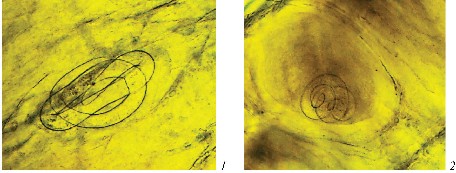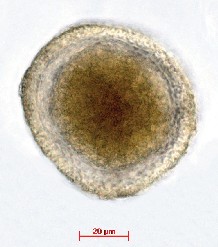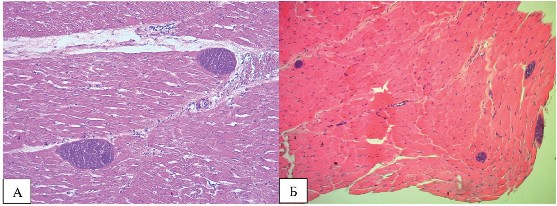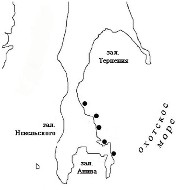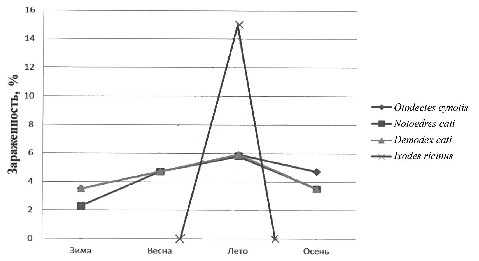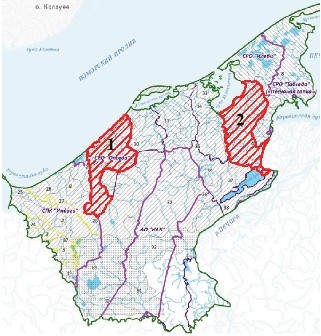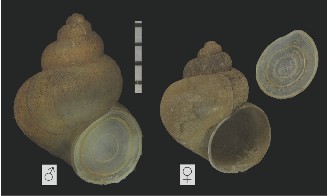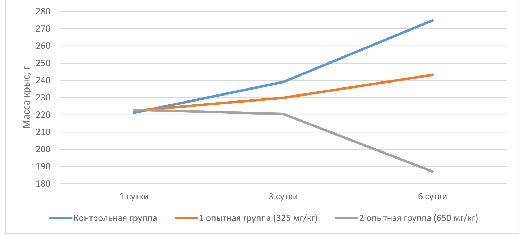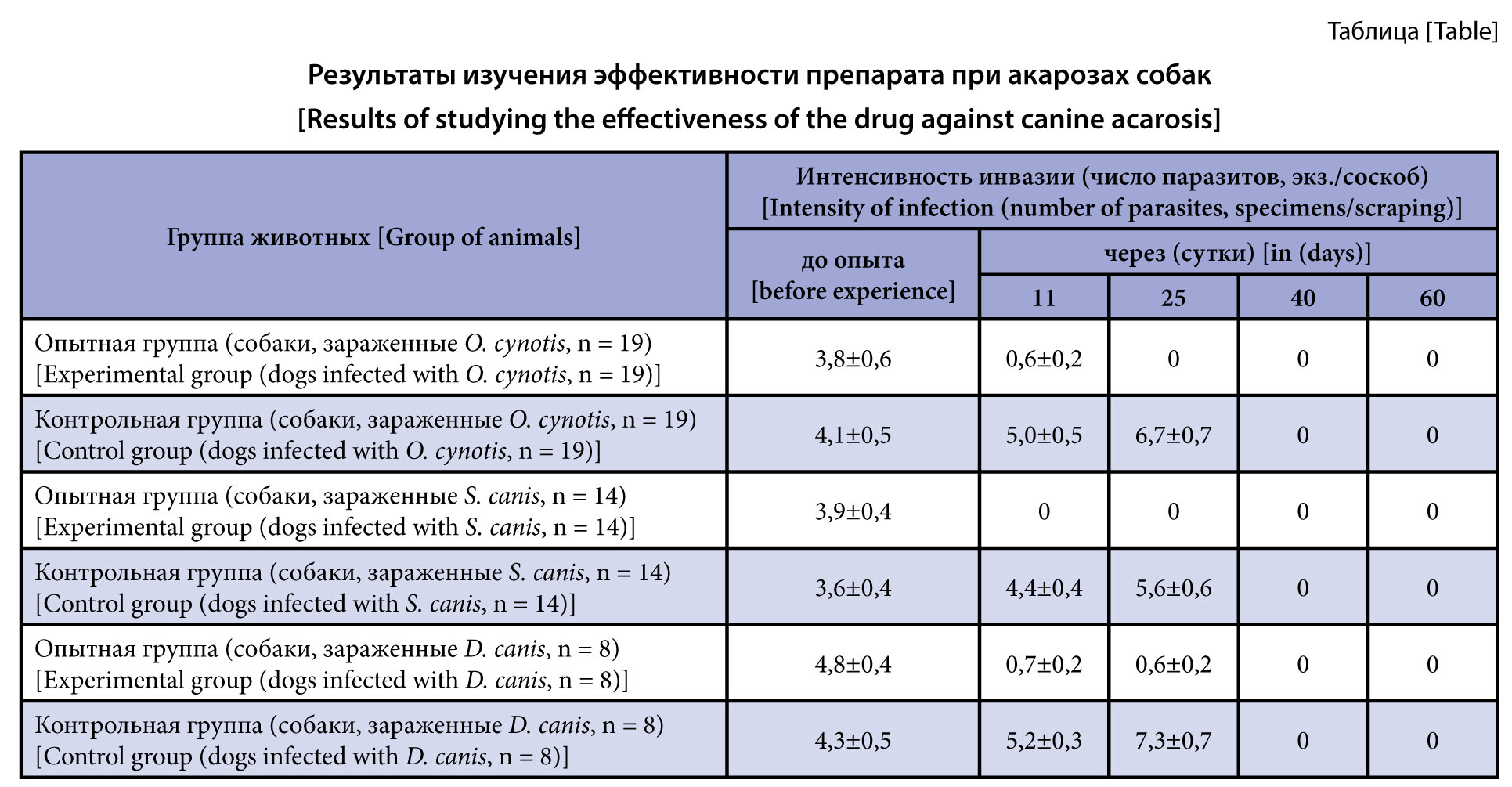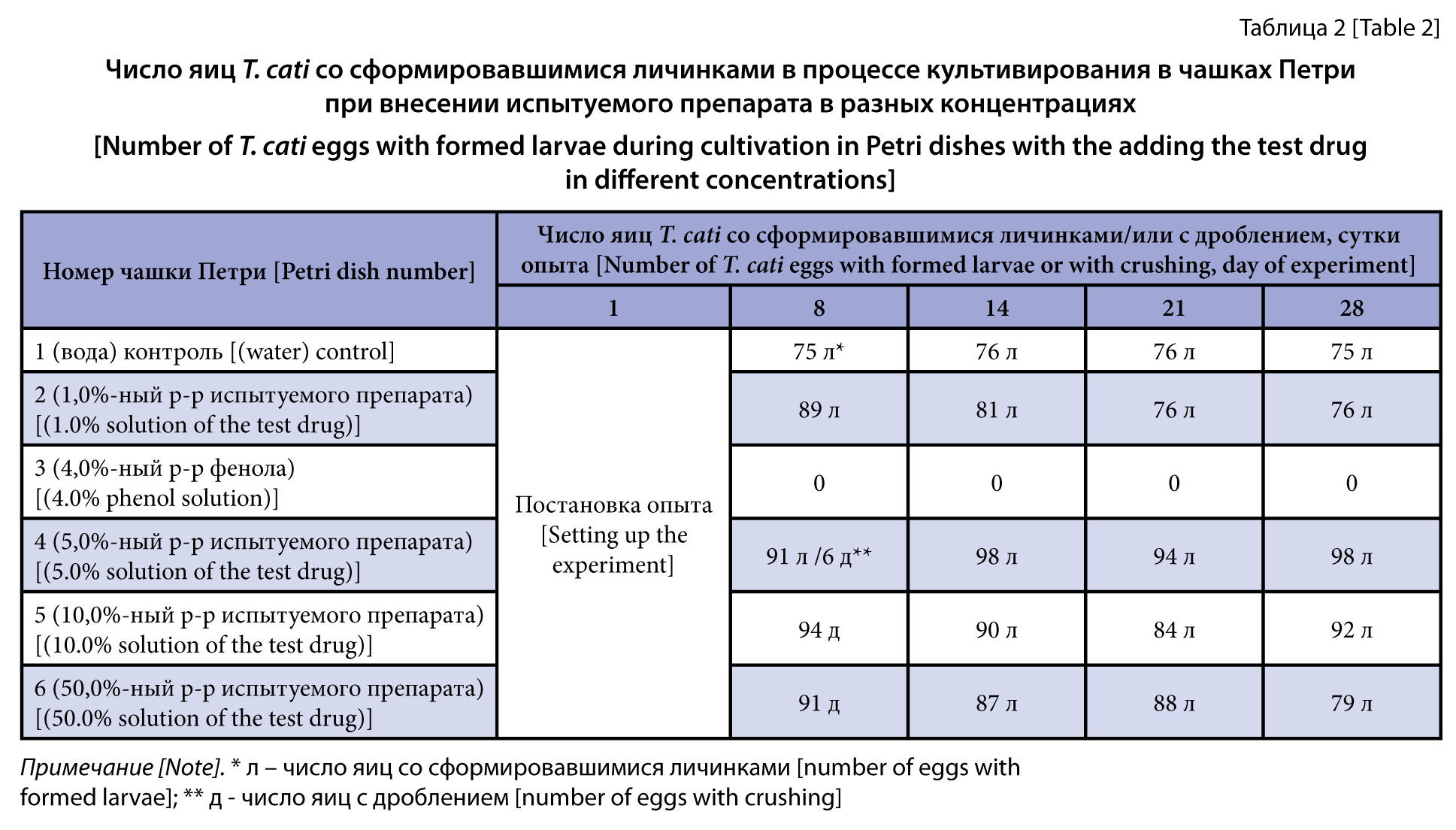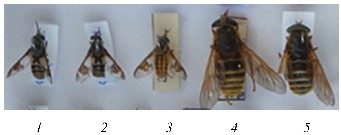OUR ANNIVERSARY
FAUNA, MORPHOLOGY AND SYSTEMATICS OF PARASITES
The purpose of the research is a comparative study of morphological changes in Trichinella spiralis capsules and larvae in the lynx and laboratory animals.
Materials and methods. The experiment used striated muscle tissue from spontaneously infected lynxes and from white rats experimentally infected with T. spiralis larvae isolated from wild animals in the Kirov Region. Morphometric studies of T. spiralis capsules and larvae in the lynx muscle tissue were conducted on temporary histologic specimens.
Results and discussion. Lemon-shaped (50%) and oval (40%) capsules were found in the entire muscle mass of the white rats, and only 10% of the larvae were round in shape. The lynx was not found to have lemon-shaped capsules; oval (60%) and round (40%) capsules predominated. The studies show that the parasite capsule size and shape indicate the adaptive abilities of T. spiralis to various types of host muscle tissue and their morphological characteristics, and are largely determined by the symplast structure and size.
The purpose of the research is to examine the helminthological status of wild carnivore mammals inhabiting the territory of the Primorsky Krai and to give an epidemiological assessment of their role in maintaining the natural foci of zoonotic infections.
Materials and methods. Feces of carnivores were collected in natural habitats of wild animals. Species of animals were identified by the characteristic features of feces and animal tracks. The shape, size, texture and composition of feces were analyzed. The samples were placed in containers with 5% formalin. A part of the material was stored in native form at -12 ºС. Muscle tissue samples were obtained from animal carcasses. Feces were examined by flotation techniques with a solution of zinc sulfate, the formalin-ethyl acetate sedimentation technique and using an ammonium nitrate solution. After the study, the samples were disinfected by autoclaving at a pressure of 1.5 atm for 2 hours. Muscle tissue samples were examined by digesting in artificial gastric juice using the Gastros device. The species of Trichinella sp. larvae isolated from the positive samples were identified using the nucleotide sequences. In total, 444 feces samples from 13 species of wild carnivore mammals and 449 muscle tissue samples from 13 species were examined.
Results and discussion. Wild carnivore mammals inhabiting the territory of the Russian Far East are often infected with various species of helminths localized in the intestine and tissues, which are causative agents of dangerous parasitic zoonoses. A total of 9 species of helminthes in the Siberian tiger (Panthera tigris altaica), 3 species in the Amur leopard (P. pardus orientalis), 2 species in the Eurasian lynx (Lynx lynx), 4 species in the leopard cat (Prionailurus bengalensis), 5 species in the sable (Martes zibellina), 2 species in the yellow-throated marten (M. flavigula), 5 species in the Siberian weasel (Mustela sibirica), 1 species in the American mink (Neovison vison), 2 species in the Asian badger (Meles leucurus), 8 species in the red fox (Vulpes vulpes), 2 species in the raccoon dog (Nyctereutes procyonoides), and 9 species in the brown bear and Asiatic black bear (Ursus arctos and U. thibetanus) were identified at studying of 444 feces samples of wild carnivore mammals in the Primorsky Krai. Among the detected helminths were highly pathogenic for humans: Toxocara cati, Paragonimus westermani and nematodes of the family Capillariidae. Trichinella sp. larvae were detected in 96 samples in the study of 449 samples of muscle tissue from wild carnivore mammals. The above types of helminths are of zoonotic nature. The pathogenic role of accidental infection with helminth species Baylisascaris transfuga has not yet been revealed in humans, that makes this type of bear ascaride potentially dangerous for humans. The studies have shown the widespread prevalence of helminth zoonoses in the Primorsky Krai. These data will help to organize properly the work of people whose jobs involve contact with wild animals.
The purpose of the research is localization and morphometry of sarcocysts in animals.
Materials and methods. Samples of striated muscle tissue of cows and wild boars were studied to determine the infection intensity and prevalence and determine morphometric parameters of cysts. Pathological material was collected to 10 % buffered formalin solution. For histological examination, muscle tissue samples were taken from the abdominal wall and cardiac muscle. To process tissue samples, paraffin coating was used in semi-automatic equipment from Thermo Scientific. Histological specimens were stained with hematoxylin and eosin and by Mallouri. The specimen histoarchitecture was assessed using an Axio A1.0 microscope; photographs were taken with AxioVision.
Results and discussion. The sarcocyst infection prevalence was 60% in cattle and 100% in the boars, with the infection intensity of 1-2 and 2-4 sarcocysts in one FOV, respectively. It was found that the cyst formed a capsule in infected boars with a thickness of 2.6±0.28 μm, while it was practically invisible in cattle, and grouped loose connective tissue fibers were observed around the cyst. The infection intensity can be assessed as low in the studied animals; however, even single parasite cysts entered the human body contribute to sarcocystosis.
The purpose of the research is to describe and analyze the qualitative and quantitative composition of pink salmon helminths of southeastern Sakhalin.
Materials and methods. Standard parasitological methods of collecting material were used. At the autopsy, the ureters, eyeballs, gill petals and arches, and the brain of fish were not examined. The method of collecting salmon parasites in the laboratory has been unchanged since 1992. Collections of representatives of monogenetic suckers were not carried out. Parasitological studies of pink salmon of southeastern Sakhalin were carried out from 1992 to 2022, a total of 4163 fish specimens were examined. The fish is caught in the estuaries of rivers and the sea coast.
Results and discussion. According to the results of their own research and literature data, the pink salmon helminth fauna of southeastern Sakhalin is represented by 23 species: Dibothriocephalus nihonkaiensis pl., Eubothrium salvelini, Eu. crassum, Nybelinia surmenicola pl., Pelichnibothrium speciosum pl., Tetraphyllidea gen. sp., Brachyphallus crenatus, Cryptocotyle sp. mtc., Hemiurus levinseni, Lecithaster gibbosus, Prosorhynchoides gracilescens, Parahemiurus merus, Derogenes varicus, Capiatestes thyrsitae, Corynosoma strumosum l., Echinorhynchus gadi, Bolbosoma caenoforme juv., B. bobrovoi juv., Rhadinorhynchus trachuri, Anisakis simplex l., Ascarophis pacifica, Ascarophis skrjabini, Hysterothylacium aduncum. The qualitative composition of the helminth fauna is currently undergoing minor changes, while the quantitative characteristics of some helminths are significantly reduced. Thus, the infection of pink salmon with Bolbosoma sp. juv scrapers. decreased to 0.61±0.18.
EPIZOOTOLOGY, EPIDEMIOLOGY AND MONITORING OF PARASITIC DISEASES
The purpose of the research is to study the epizootic situation of ectoparasitosis of cats in the Moscow metropolis, taking into account the season and the age of the animals.
Materials and methods. The study of the seasonal and age dynamics of infection of cats with ectoparasites in the Moscow metropolis was carried out on the basis of the All-Russian Scientific Research Institute of Infectious Diseases (VNIIP), a branch of the Federal State Budgetary Institution FSC VIEV RAS, as well as the veterinary clinic GLOBALVET CLINIC LLC (Moscow) in 2020–2022. We examined 85 cats in different seasons. When examining the animals, attention was paid to damage to the skin and hair. At the same time, the gender, age, condition of the skin and hair of the animals were taken into account; the ears were examined and the hair was combed using a magnifying glass; Microscopic examination of the ear contents, as well as scrapings of the superficial and deep layers of the skin. The number of ectoparasites was determined according to the method of M. V. Arisov, I. A. Arkhipov (2018). The results obtained were processed statistically using Microsoft Excel.
Results and discussion. Infection of cats with Demodex cati was maximum in Spring and Summer (5.9%), and decreased to 3.5% in Autumn and Winter. Ixodes ricinus mites were found on the skin and hair of cats (15%) only in the warm season. We noted an increase in the infection of cats with Otodectes cynotis and Notoedres cati in Spring and Summer. The seasonal dynamics of infection of cats by insects of different species differed. Fleas were found in 4.7% of cats in Winter, and in 8.5 and 10.6% of cats in Spring and Summer, respectively. The infection of cats with lice eaters was low.
The purpose of the research is to establish the prevalence of vector-borne diseases in reindeer (Rangifer tarandus) Bolshezemelskaya and Malozemelskaya tundra.
Materials and methods. The research was carried out in 2022–2023 on domesticated reindeer living in the Bolshezemelskaya and Malozemelskaya tundra of the Nenets Autonomous Okrug and the Komi Republic. Stabilized blood was obtained from animals by random sampling and PCR studies were performed for the presence of genetic material of pathogens of the genera Anaplasma, Babesia and Theileria.
Results and discussion. The DNA of the causative agent of anaplasmosis was isolated from 14.3% of reindeer from Malozemelskaya (family-tribal community «Vy Tu» (VTU) and «Opseda» (OPS)) and 30.6% of Bolshezemelskaya tundra (Аgricultural production cooperative «Harp» (HARP) and Collective Farm «Izhemsky olenevod and Co» (IZHM)). To a greater extent, vazhenki and calves were infected with anaplasmosis, to a lesser extent – choirs. Genetic material of Babesia pathogens was found in 53.1% of VTU and OPS deer and 36.7% of HARP and IZHM, while babesiosis was most often observed in the chorus group. Teileriosis was found in 10.2% and 4.1% of animal samples among the herds of the Malozemelskaya and Bolshezemelskaya tundra, respectively. The genetic material of the causative agent of teileriosis was isolated mainly from the blood obtained from calves. The causative agent of theileriosis was not found in the biological material of the choirs. The presence of DNA Anaplasma spp. and Babesia spp. in one sample, the proportion of deer from Malozemelskaya tundra herds was 2.4%, from Bolshezemelskaya – 26.5%. The combined course of babesiosis and teileriosis was found to be 8.2% only in VTU and OPS deer. Thus, studies have shown that vector-borne diseases is widespread among the reindeer of the studied farms of the Bolshezemelskaya and Malozemelskaya tundra.
The purpose of the research is to summarize our own and literature data on the Irkutsk focus of opisthorchosis.
Materials and methods. The materials (mollusks, cyprinids and muskrat) were collected in the reservoirs of the Biryusa River basin. Mollusks were identified using the key by Ya. I. Starobogatova et al. (2004). The fish were studied for metacercariae of the trematode Opisthorchis felineus using the conventional compression method according to the recommendations and using the method of digestion with artificial gastric juice.
Results and discussion. According to our own and literature data, there is a focus of mixed type opisthorchosis in the Taishetsky District, the Irkutsk Region, in which the final hosts of the parasite are wild animals, namely, the muskrat, along with domestic animals (cats) and humans. The first intermediate host is Opisthorchophorus troscheli. The second intermediate hosts are four fish species (roach, dace, crucian carp, and bream); minnow and tench were not infected with Opisthorchis sp. Mapping of current data has showed its distribution in the Biryusa River basin. The current state of knowledge for the Irkutsk focus of opisthorchosis shows that a comprehensive research plan is needed with the participation of scientific and regulatory institutions of the Irkutsk Region and Taishetsky District.
BIOCHEMISTRY, BIOTECHNOLOGY AND DIAGNOSTICS
The purpose of the research is to analyze the literature devoted to the study of the physiological role and functional significance of biologically active substances: FMRFamide-like neuropeptides in the locomotion of root-knot nematodes Meloidogyne incognita, M. minor, M. hapla and M. graminicola using immunological, phylogenetic, molecular and bioinformatic research methods.
Results and discussion. The present work shows the importance of endogenous FMRFamide-like neuropeptides (FLPs) in such behavioral reactions of plant nematodes as locomotion, which ensures the vital activity of plant parasites; the functional significance of flp genes in the neurobiology of root-knot nematodes is discussed. It was especially noted that the main physiological and functional characteristics of endogenous FLP in root-knot nematodes were obtained as a result of studies of the functional role of the flp genes encoding these neuropeptides. In the nematodes M. incognita and M. graminicola, components of the peptidergic nervous system were identified in the nervous structures: FMRFamide-like positive immunoreactivity, FLP, flp genes encoding neuropeptides, and G-protein-coupled receptors (GPCR) activated by these neuropeptides. It was shown that the main functional characteristics of endogenous FLPs in nematodes were obtained using one of the methods of reverse genetics, i.e., flp genes knockdown in shadow by means of RNA-interference. It has been established that FLP cause two types of physiological effects on the somatic muscles of root-knot nematodes – stimulation of the locomotor activity of the muscles and its inhibition. In most works, the data obtained on the physiological effects of neuropeptides on the locomotor activity of phytonematodes are considered with a view to their possible use in the development of new targeted anthelmintic drugs.
PHARMACOLOGY, TOXICOLOGY
The purpose of the research is to determine main toxicological parameters in repeated intragastric administration of Altric-Extra for veterinary use to laboratory outbred rats.
Materials and methods. White outbred rats were used as a test system in the study. The experiment used clinical, toxicological, biochemical and morphological research methods.
Results and discussion. Altric-Extra doses of 325 and 650 mg/kg were toxic for the laboratory animals. When administered daily intragastrically to the rats in the above doses, the drug had a negative effect on the functional status of the hemopoietic organs, and excretory and digestive systems. The main target organ for this drug is the thymus. Functional disorders in the above organs and systems are irreversible as evidenced by the post-mortem examination, general blood analysis, and biochemical blood test obtained 10 days after the drug administration was completed.
TREATMENT AND PREVENTION
The purpose of the research is to study the efficacy of the drug in the form of spray based on Fipronil, Moxidectin and Pyriproxyfen against canine acarosis.
Materials and methods. The assessment of the acaricidal effect of multicomponent drug against canine acarosis was carried out on the basis of the All-Russian Scientific Research Institute of Infectious Diseases (VNIIP), a branch of the Federal State Budgetary Institution FSC VIEV RAS, as well as the veterinary clinic GLOBALVET CLINIC LLC (Moscow) in 2020–2022. 82 dogs were used in the experiments, including those spontaneously infected with Otodectes cynotis (38 sp.), Sarcoptes canis (28 sp.), and Demodex canis (16 sp.). The animals were divided into experimental and control groups. To the infected animals of the experimental groups, the drug was applied in the form of spray to the affected areas of the body at the rate of 1 ml per 10 cm2, 2–4 times with an interval of 7 days. The dogs in the control group were treated at the end of the experiment. The efficacy of the drug was taken into account by examining and recording the number of ticks in animals before and 3, 11, 25, 40 and 60 days after treatment. The results were processed statistically using Microsoft Excel.
Results and discussion. On the 11th day, all animals showed extinction of clinical signs, healing of affected skin areas and scratches, and the appearance of new hair in areas of alopecia; microscopy of scrapings revealed single mites, deformed larvae and eggs. Microscopy of skin scrapings on the 25th day revealed single mites in 5 dogs affected by demodicosis. On the 40th day, upon examination and acarological examination of animal skin scrapings, no S. canis, O. cynotis and D. canis mites were found. The research results showed 100% efficacy of the drug.
The purpose of the research is to study ovocidal properties of a microbial agent for composting that has lactobacilli (Lactobacillus casei and L. plantarum) and microscopic fungi (Saccharomyces cerevisiae) present as active components for Toxocara cati eggs in vitro experiment.
Materials and methods. The tested microbial agent is used for compost preparation and liquid household waste processing. The agent is a homogeneous yellow liquid with a bacterial biomass in titers of 106 -108 CFU/cm3 which is placed in a ten-liter canister. First, a culture of Toxocara cati eggs was prepared, then ovocidal properties of aqueous standard solutions of the test agent were studied in four concentrations, 1.0%; 5.0; 10.0 and 50.0% versus a 4.0% phenol solution in vitro experiment.
Results and discussion. The ovocidal effect of the tested aqueous microbiological agent solutions in the above concentrations in vitro experiment on T. cati eggs was not detected. A 4.0% phenol solution used as a reference solution showed high efficacy.
The purpose of the research is to develop a method for protecting herd horses from dangerous blood-sucking dipterans that ensures organic meat production without pesticides.
Materials and methods. Dangerous dipterans were collected and counted using an entomological net. The Diptera species identification was determined using the morphological keys. A new technology for protecting herd horses from harmful insects without pesticides used was implemented at Horobut LLC in the Megino-Kangalassky District, the Republic of Sakha (Yakutia) in 2021–2023. Pursuant to the Assignment and Regulations, a patent search was performed in the Russian scientific and technical literature on the subject “Develop methods for creating technologies to control and prevent animal diseases that ensure organic food production from conventional agricultural sectors in the Far North”.
Results and discussion. The number of mosquitoes and horseflies that attack herd horses in Central Yakutia was established. In the morning and evening peaks, the number of mosquitoes for a 5-minute count was 397–456 mosquitoes belonging to 15 species of three genera: Aedes (Ochlerotatus), Culiseta and Anopheles. During a 15-minute count, the bait horse was attacked by 83 to 107 specimens of horseflies of 21 species and one subspecies of two genera, Hybomitra and Chrysops. For the first time in Central Yakutia, a method of protecting herd horses from attacks by blood-sucking insects was used with positive results without spraying animals with insecticides.
THE MEMORY OF THE SCIENTIST
ISSN 2541-7843 (Online)




